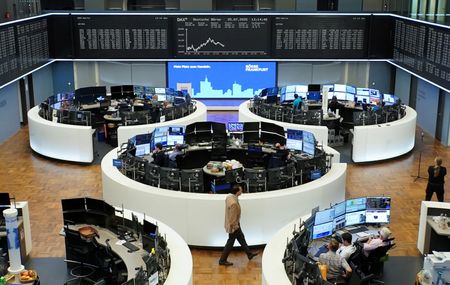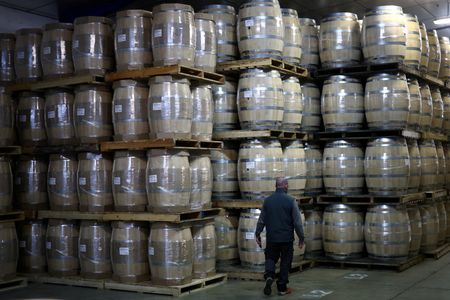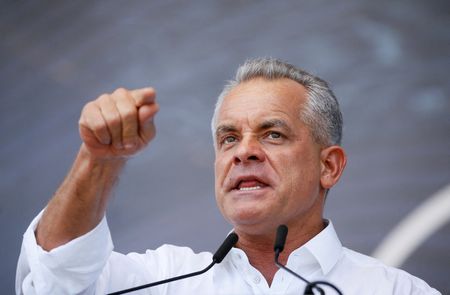By Lucy Raitano and Linda Pasquini
LONDON/GDANSK (Reuters) -European stocks are near record highs again, seemingly shaking off tense trade talks and currency headwinds, while volatility has evaporated, giving rise to four key themes that investors are playing as they wait for the next major catalyst.
The STOXX 600 posted its best first-quarter relative to the S&P 500 in a decade – but is now clocking an 8.4% gain in 2025, just a touch ahead of the S&P 500’s 8.2% rise.
The European Union over the weekend reached a framework deal with the U.S. for tariffs of 15%. But optimism has been building for some time that the two sides would avert a damaging trade war and the data points to an economy that is holding up for now. Investors are warming to four key themes at play under the surface of the European stock market.
1) EXPORTERS LAG DOMESTIC-FOCUSED STOCKS
A performance gap has emerged between euro zone domestic-focused stocks and exporters, all thanks to a stronger euro, which has risen 13.4% versus the dollar in 2025, hurting exporter earnings.
Trade-sensitive sectors like autos and consumer durables have fallen behind, while domestically-oriented stocks like banks and utilities have soared.
A STOXX autos basket added over 3% last week after news of a U.S.-Japan trade deal, but is still about 1% lower in 2025, a stark contrast to a 35% increase in bank stocks and 15% surge in utilities.
Analysts have been revising down overall 2025 earnings forecasts in Europe, but zooming in, there is a clear split between the pace of earnings revisions for euro zone exporters versus domestic plays, with the forward EPS of exporters dropping at an accelerated pace.
JPMorgan equity strategists advise clients to keep favouring domestics over exporters in their non-U.S. portfolios, while Barclays equity strategists say the current positioning gap is so extreme that the risk of a reversal is rising.
Helen Jewell, CIO of BlackRock Fundamental Equities EMEA, flagged select opportunities in the export-focused luxury and semiconductor sectors.
“If we get some resolution of where the tariffs are and if we get some sort of levelling out of the dollar, I think these names will start to perform well, and that could potentially be the second leg for the European story,” Jewell said.
2) HALO EFFECT
Germany’s massive spending plans, aimed at boosting the country’s economy after decades of fiscal conservatism, brought optimism to broader European markets, as EU companies are set to benefit from increased spending on defense and infrastructure.
The U.S. tariff announcement in April caused a massive stock sell-off, but the German DAX has since recovered to touch a fresh year high in July. Midcap stocks have followed a similar path. Both indexes are up over 20% this year and set for their strongest annual performance since 2019.
“The relevance of Germany as a market for EU countries is great,” Uwe Hohmann, equity strategist at Metzler Capital Markets said, pointing to the country’s strong trade relationship with other EU states.
Germany’s spending plans will have a modest effect on European growth, according to the European Commission’s spring economic forecasts, but the market impact is expected to be profound.
“…the optimism around the German fiscal balance will still be the main driver of European markets in the next years,” said Nabil Milali, portfolio manager at Edmond de Rothschild Asset Management, warning however that money will not concretely flow into the economy until 2026 at least.
A potential deterioration in trade relationships with the U.S. or China could dampen sentiment on European equity markets, at least in the short term.
“It would then only and mostly solely depend on what’s going on in the German political arena, which is, I think, probably not good enough on a standalone basis to support an overall positive trend,” said Hohmann.
3) SMALL CAPS STEAL THE SPOTLIGHT
European small-caps are on track to outperform large-caps in Europe for the first time since 2020.
A basket of European small caps is up 13.4% in 2025, outperforming its large cap counterpart which is up 9.1%, for the first time since 2020. Since April, Graham Secker, head of equity strategy, Pictet Wealth Management said a stronger euro and better economic outlook have driven the small-cap turnaround.
“European small-caps were the proverbial value-trap: you’re cheap but you stay cheap until something changes,” said Secker, adding that in illiquid areas of the market, it doesn’t take much to move the dial.
“There has been a lot of interest with the fiscal stimulus announcement out of Germany for revisiting German mid- and small-caps, as probably the cleanest way to play the fiscal push that’s coming through Europe,” Secker said.
4) SMALLER MARKETS ALSO PACK A PUNCH
Talking size, some smaller markets have also been outperforming the wider European landscape this year. Indexes in Czech Republic, Greece and Poland have added 25%, 35% and 37%, respectively, compared with an 8% rise in the STOXX 600.
“I think the positioning of investors is going more and more towards these smaller markets” which are benefiting from sectorial factors and higher exposure to the domestic economy, said Edmond de Rothschild’s Milali.
(Reporting by Lucy Raitano and Linda Pasquini; Editing by Amanda Cooper and Toby Chopra)











